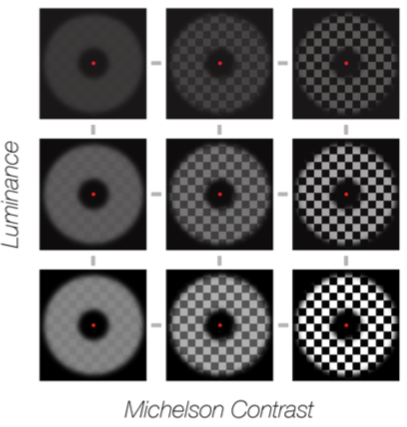Luminance potentiates human visuocortical responses
Journal of Neurophysiology (2020)
Louis Vinke & Sam Ling
 Our visual system is tasked with transforming variations in light within our environment into a coherent percept, typically described using properties such as luminance and contrast. Models of vision often downplay the impor- tance of luminance in shaping cortical responses, instead prioritizing representations that do not covary with overall luminance (i.e., con- trast), and yet visuocortical response properties that may reflect luminance encoding remain poorly understood. In this study, we examined whether well-established visuocortical response properties may also reflect luminance encoding, challenging the idea that lumi- nance information itself plays no significant role in supporting visual perception. To do so, we measured functional activity in human visual cortex when presenting stimuli varying in contrast and mean lumi- nance, and found that luminance response functions are strongly contrast dependent between 50 and 250 cd/m2, confirmed with a subsequent experiment. High-contrast stimuli produced linearly in- creasing responses as luminance increased logarithmically for all early visual areas, whereas low-contrast stimuli produced either flat (V1) or assorted positive linear (V2 and V3) response profiles. These results reveal that the mean luminance information of a visual signal persists within visuocortical representations, potentially reflecting an inherent imbalance of excitatory and inhibitory components that can be either contrast dependent (V1 and V2) or contrast invariant (V3). The role of luminance should be considered when the aim is to drive potent visually evoked responses and when activity is compared across studies. More broadly, overall luminance should be weighed heavily as a core feature of the visual system and should play a significant role in cortical models of vision.
Our visual system is tasked with transforming variations in light within our environment into a coherent percept, typically described using properties such as luminance and contrast. Models of vision often downplay the impor- tance of luminance in shaping cortical responses, instead prioritizing representations that do not covary with overall luminance (i.e., con- trast), and yet visuocortical response properties that may reflect luminance encoding remain poorly understood. In this study, we examined whether well-established visuocortical response properties may also reflect luminance encoding, challenging the idea that lumi- nance information itself plays no significant role in supporting visual perception. To do so, we measured functional activity in human visual cortex when presenting stimuli varying in contrast and mean lumi- nance, and found that luminance response functions are strongly contrast dependent between 50 and 250 cd/m2, confirmed with a subsequent experiment. High-contrast stimuli produced linearly in- creasing responses as luminance increased logarithmically for all early visual areas, whereas low-contrast stimuli produced either flat (V1) or assorted positive linear (V2 and V3) response profiles. These results reveal that the mean luminance information of a visual signal persists within visuocortical representations, potentially reflecting an inherent imbalance of excitatory and inhibitory components that can be either contrast dependent (V1 and V2) or contrast invariant (V3). The role of luminance should be considered when the aim is to drive potent visually evoked responses and when activity is compared across studies. More broadly, overall luminance should be weighed heavily as a core feature of the visual system and should play a significant role in cortical models of vision.

